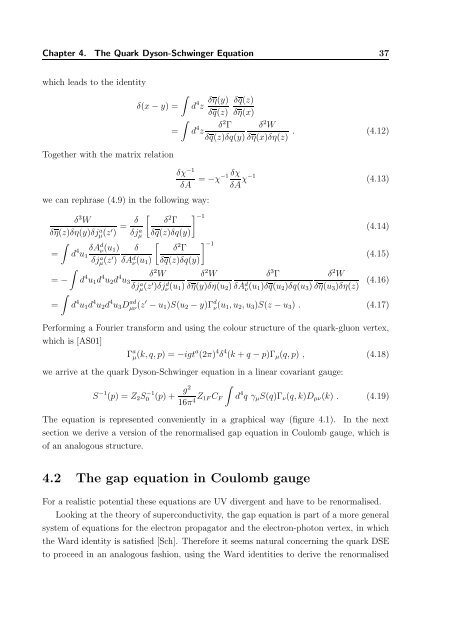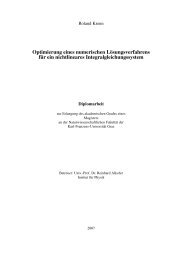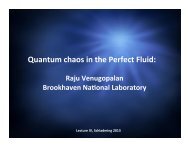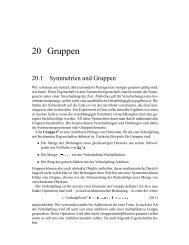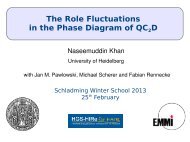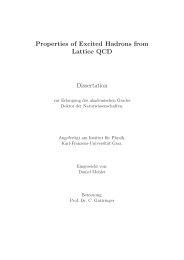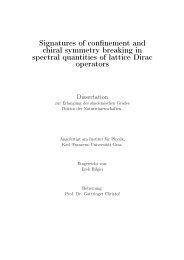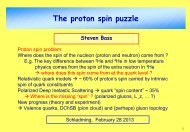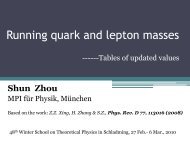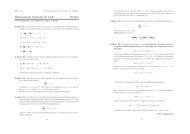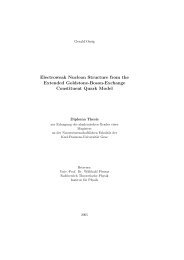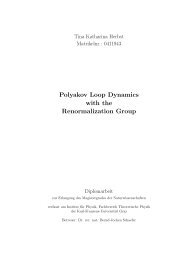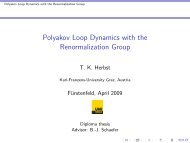The QCD Quark Propagator in Coulomb Gauge and - Institut für Physik
The QCD Quark Propagator in Coulomb Gauge and - Institut für Physik
The QCD Quark Propagator in Coulomb Gauge and - Institut für Physik
You also want an ePaper? Increase the reach of your titles
YUMPU automatically turns print PDFs into web optimized ePapers that Google loves.
Chapter 4. <strong>The</strong> <strong>Quark</strong> Dyson-Schw<strong>in</strong>ger Equation 37<br />
which leads to the identity<br />
∫<br />
δ(x − y) =<br />
∫<br />
=<br />
d 4 z δη(y) δq(z)<br />
δq(z) δη(x)<br />
d 4 δ 2 Γ δ 2 W<br />
z<br />
δq(z)δq(y) δη(x)δη(z) . (4.12)<br />
Together with the matrix relation<br />
δχ −1<br />
δA<br />
we can rephrase (4.9) <strong>in</strong> the follow<strong>in</strong>g way:<br />
= −χ−1<br />
δχ<br />
δA χ−1 (4.13)<br />
δ 3 W<br />
δη(z)δη(y)δjµ(z a ′ ) = δ [ ]<br />
δ 2 −1<br />
Γ<br />
(4.14)<br />
δjµ<br />
a δq(z)δq(y)<br />
∫<br />
= d 4 δA d ν<br />
u (u [ ]<br />
1) δ δ 2 −1<br />
Γ<br />
1 (4.15)<br />
δjµ(z a ′ ) δA d ν(u 1 ) δq(z)δq(y)<br />
∫<br />
= − d 4 u 1 d 4 u 2 d 4 δ 2 W δ 2 W δ 3 Γ δ 2 W<br />
u 3<br />
δjµ a (z′ )δjν d(u 1) δη(y)δη(u 2 ) δA d ν (u (4.16)<br />
1)δq(u 2 )δq(u 3 ) δη(u 3 )δη(z)<br />
∫<br />
= d 4 u 1 d 4 u 2 d 4 u 3 Dµν ad (z′ − u 1 )S(u 2 − y)Γ d ν (u 1, u 2 , u 3 )S(z − u 3 ) . (4.17)<br />
Perform<strong>in</strong>g a Fourier transform <strong>and</strong> us<strong>in</strong>g the colour structure of the quark-gluon vertex,<br />
which is [AS01]<br />
Γ a µ(k, q, p) = −igt a (2π) 4 δ 4 (k + q − p)Γ µ (q, p) , (4.18)<br />
we arrive at the quark Dyson-Schw<strong>in</strong>ger equation <strong>in</strong> a l<strong>in</strong>ear covariant gauge:<br />
∫<br />
S −1 (p) = Z 2 S0 −1 (p) + g2<br />
16π 4Z 1FC F d 4 q γ µ S(q)Γ ν (q, k)D µν (k) . (4.19)<br />
<strong>The</strong> equation is represented conveniently <strong>in</strong> a graphical way (figure 4.1). In the next<br />
section we derive a version of the renormalised gap equation <strong>in</strong> <strong>Coulomb</strong> gauge, which is<br />
of an analogous structure.<br />
4.2 <strong>The</strong> gap equation <strong>in</strong> <strong>Coulomb</strong> gauge<br />
For a realistic potential these equations are UV divergent <strong>and</strong> have to be renormalised.<br />
Look<strong>in</strong>g at the theory of superconductivity, the gap equation is part of a more general<br />
system of equations for the electron propagator <strong>and</strong> the electron-photon vertex, <strong>in</strong> which<br />
the Ward identity is satisfied [Sch]. <strong>The</strong>refore it seems natural concern<strong>in</strong>g the quark DSE<br />
to proceed <strong>in</strong> an analogous fashion, us<strong>in</strong>g the Ward identities to derive the renormalised


